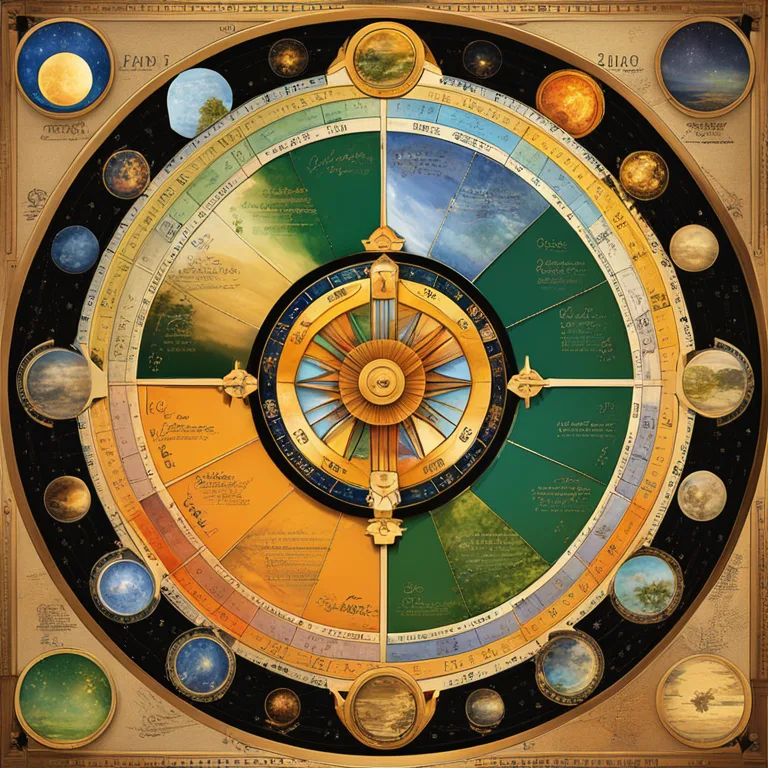
The Essentials of Birth Chart Wheels
Delve into the basics of birth chart wheels and their significance in personal astrology.
article by Priya Deshmukh
Your Cosmic Blueprint
Astrology offers a window into the intricate dynamics of personality, potential, and life paths through a practice called birth chart wheel analysis. These celestial maps are crafted based on the exact time, date, and location of one's birth. As the positions of the stars and planets change, so do the nuances of each birth chart, making every individual's chart as unique as their fingerprint. Birth charts are not only meant for predicting future events but also serve as tools for understanding oneself and one's place in the cosmos.

Anatomy of a Birth Chart
A birth chart wheel comprises several components including the twelve houses, signs, and planetary placements. Each house corresponds to different areas of life, such as relationships, career, or health, and the signs reflect how these areas are expressed. The planets add another layer - they represent different energies or forces that influence these expressions. These components work in concert to describe a complex, dynamic picture of an individual's potential energies and experiences.

The Zodiac's Role
Central to astrology is the Zodiac, a belt of the heavens divided into twelve equal parts, each named after the constellation that originally occupied its sector. The planetary placements within these signs at your birth moment significantly affect your disposition. For instance, planets like Mars and Venus influence your assertiveness and affectionate nature, respectively, and their Zodiac signs color these influences—Mars in Aries exhibits differently than Mars in Cancer.

Planetary Aspects
Crucial to interpreting a birth chart are the aspects, or angles, that planets form with one another. These angles create a nuanced map of relationships that can enhance or challenge life's journey. Conjunctions, oppositions, trines, and squares each tell a story of harmonies and tensions, providing depth to the astrological analysis. Understanding these aspects can give profound insight into personal dynamics and how one may navigate through various life stages.

Transits and Progressions
While a birth chart remains static, the actual celestial bodies continue to move and form new relationships with those positions. These transitory phenomena are significant for predictive astrology. For example, Saturn's return, occurring approximately every 29.5 years, marks significant life milestones and growth. Progressions, another forecasting technique, involve advancing the birth chart to reflect personal development and maturity over time.
Modern Relevance
Astrology is not a stagnant field; it evolves as our understanding of the universe does. The inclusion of newfound celestial objects like asteroids and dwarf planets (such as Ceres and Pluto) in chart readings exemplifies astrology's adaptability. Additionally, astrological software and apps developed with state-of-the-art astronomical data have made generating and interpreting birth charts more accessible than ever in 2024 and beyond.
Your Personal Journey
Lastly, it is crucial to remember that a birth chart is not a deterministic scroll. It provides potential pathways and inclinations, and the agency remains with the individual. The chart is a starting point for introspection and self-discovery, fostering a better understanding of one's inner workings and how one may gracefully align with the cosmic tides.
Published: 12/22/2023
Modified: 12/22/2023
More predictions
Come back here soon to learn more about yourself and your future


Astrology Houses: The Roadmap of Destiny
Delve into the fundamental elements of astrological houses and their meanings in personal astrology charts.


Understanding 12 Astrological Houses
Delve into the meanings and influences of the twelve astrological houses that shape personal horoscopes.


The Role of Astrological Houses
Discover the fundamental concepts of astrological houses and how they influence personal astrological charts.